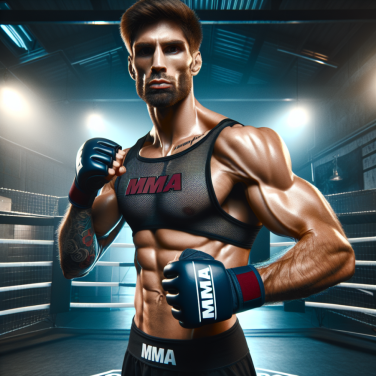Tracing the Sartorial Journey: Jon Jones' Fightwear Through the Years
As one of the most dominant figures in mixed martial arts, Jon 'Bones' Jones has not only left an impression with his unparalleled skills in the octagon but also with his distinctive fightwear, which has evolved significantly over his career. His sartorial journey reflects not only his personal growth and changes in sponsorship but also the shifts in MMA fashion trends and advancements in sportswear technology.
In the early days, like many fighters, Jon Jones stepped into the cage with relatively generic trunks. Typically adorned with sponsor patches and simple color schemes, these shorts were functional but far from the personalized kits we see fighters sporting today. This was an era where high-profile branding was key, and the shorts served as a canvas for sponsors rather than a statement of personal style.
As Jones' reputation grew, so did the attention paid to his fightwear. This was exemplified in his UFC debut against Andre Gusmao at UFC 87, where he wore unadorned, yet bold, black shorts that helped him stand out among the crowded roster of UFC hopefuls. Even in these early stages, Jones' preference for longer shorts with a loose fit was apparent, a choice likely influenced by his background in wrestling and the need for ease of movement.
Moving through his championship reign, Jones' shorts began to reflect his status at the top of the sport. Signature fightwear became a part of his brand – typically designed in collaboration with his sponsors, these shorts became more sophisticated and incorporated the light heavyweight champ's personal logo. His color palette diversified, including blacks and grays accentuated by striking hues that matched his team colors or personal preferences.
An interesting evolution occurred when Reebok entered the MMA scene as the official outfitter for the UFC, which moved all fighters, including Jones, into standardized kits. This era saw Jones in the sleek designs of the Reebok era, with minimalistic branding and a more uniform look that brought a sense of cohesion to UFC apparel but limited individual expression. Despite the standardized issue, Jones could occasionally personalize his shorts with his name, nickname, and choice of colors reflecting his unique persona.
As fightwear technology progressed, so did the materials and fit of Jones' shorts. The focus shifted towards performance fabrics that could wick moisture away, resist blood and sweat, and incorporate aspects of compression to support the athlete's muscles. The versatility and durability of lightweight materials also allowed for less restriction in movement, a crucial factor in MMA where every millimeter counts.
Read also:
Conquest MMA: Unleashing the Warriors of the Cage
The Fabric of a Champion: Analyzing the Shifts in Jon Jones' MMA Shorts Design
Jon Jones, widely recognized as one of the greatest mixed martial artists of all time, not only leaves an indelible mark with his fighting prowess but also with his distinct and evolving choice in MMA shorts design. Over the years, Jones' fight gear has undergone several transformations, reflecting his personal brand, professional affiliations, and the changing landscape of fight wear sponsors in MMA.
In the initial phase of his illustrious career, Jon Jones stepped into the cage donning fairly straightforward and sponsor-laden shorts, epitomizing the bygone era of MMA where functionality and financial backing took precedence over personal style. The early shorts often showcased a classic design with prominent brand logos plastered across. Brands like Affliction and FORM Athletics were prominently displayed, but the designs remained utilitarian, suited for the sport's demands yet holding limited aesthetic distinction.
As Jones' career progressed and his status as a dominant champion was cemented, the evolution of his fight shorts mirrored his growing influence in the sport. His endorsement deals became more lucrative, and the designs of his shorts started to become more personalized. More than just a billboard for sponsor logos, they began to integrate elements symbolizing his fighting spirit and individual identity. The color schemes often included black or grey, which were complemented by bold, contrasting colors that stood out during his matches. The presence of the Nike swoosh during his stint with Nike signified a shift towards mainstream sports recognition for MMA athletes.
The introduction of Reebok as the official apparel sponsor of the UFC in 2015 marked a significant shift in the presentation of all fighters, including Jones. Gone were the days of individually sponsored logos and personalized eccentricities in favor of a uniform look across the board. However, for high-profile athletes like Jones, customizations within the Reebok framework allowed for some level of individual expression. Jones' Reebok shorts were characterized by sleek design, often featuring his nickname "Bones" and integrating subtle symbolism, such as a lion or his initials, representing his ferocity and competitive spirit in a more understated manner.
With the conclusion of the Reebok era and the entrance of Venum as the UFC's outfitting partner, Jones' fight wear continued to evolve. The Venum shorts Jones sported carried forward the streamlining of the athletic design with enhanced functionality and comfort, also allowing space for a unique expression as it catered to Jones' champion status.




